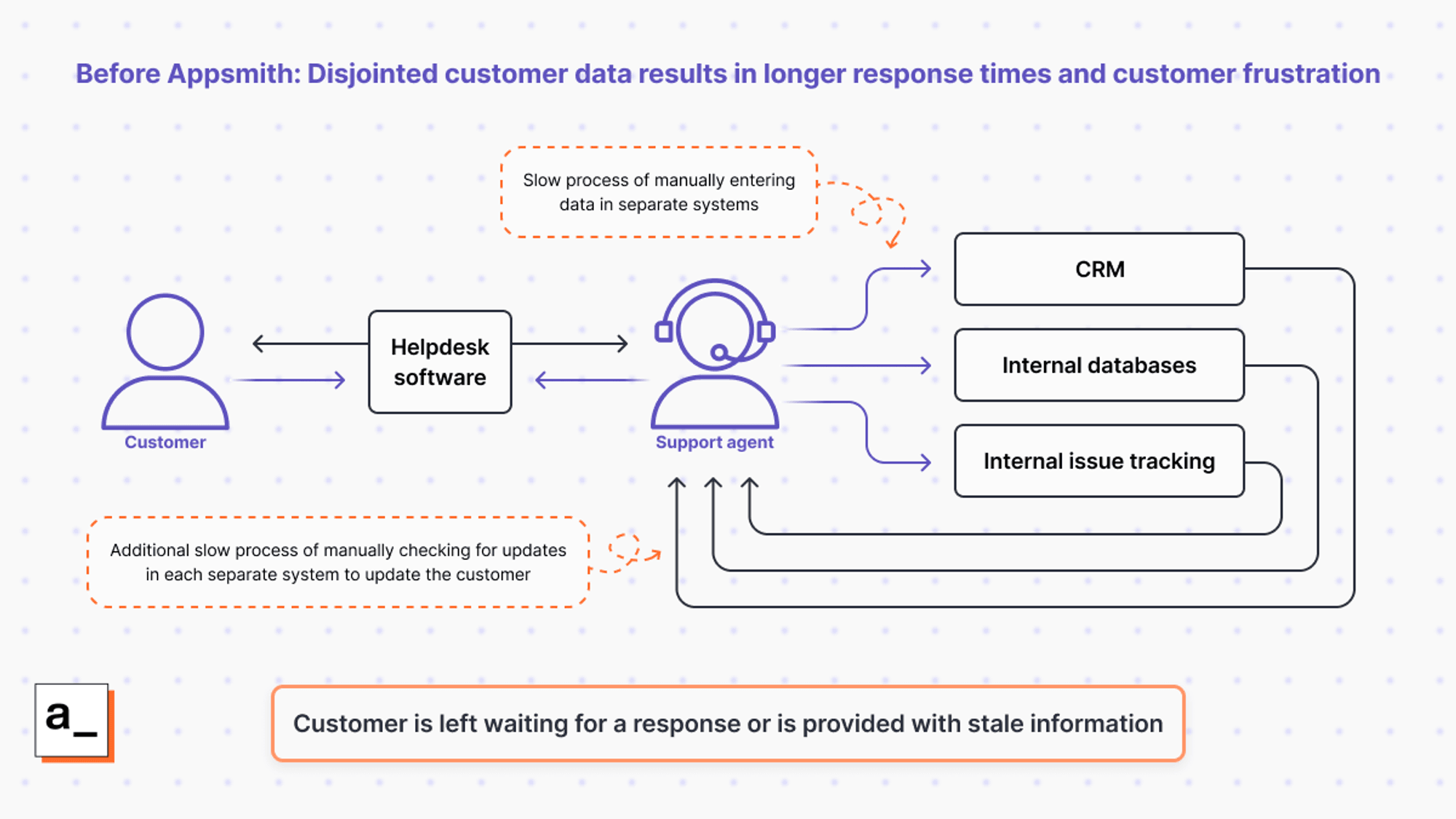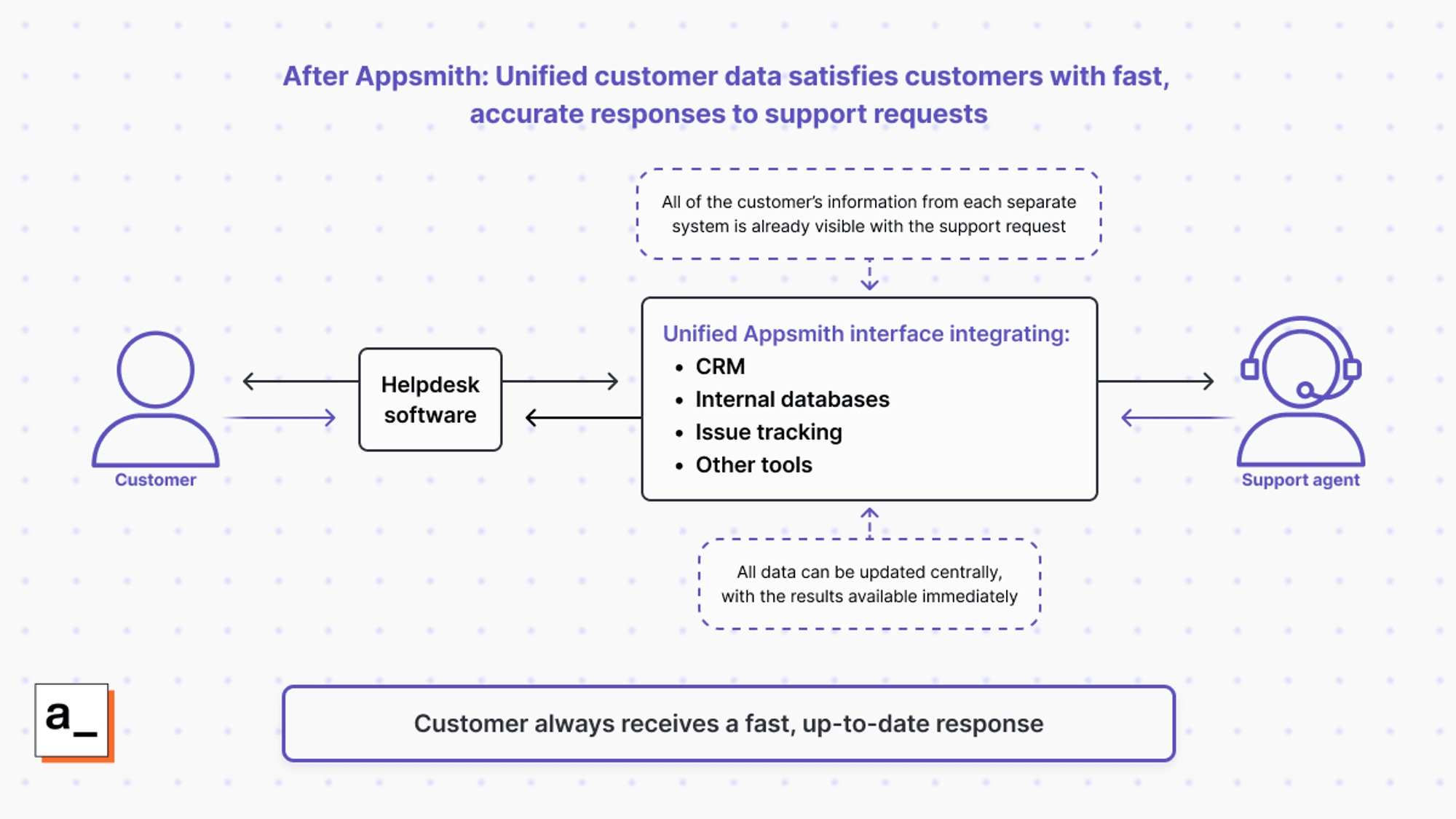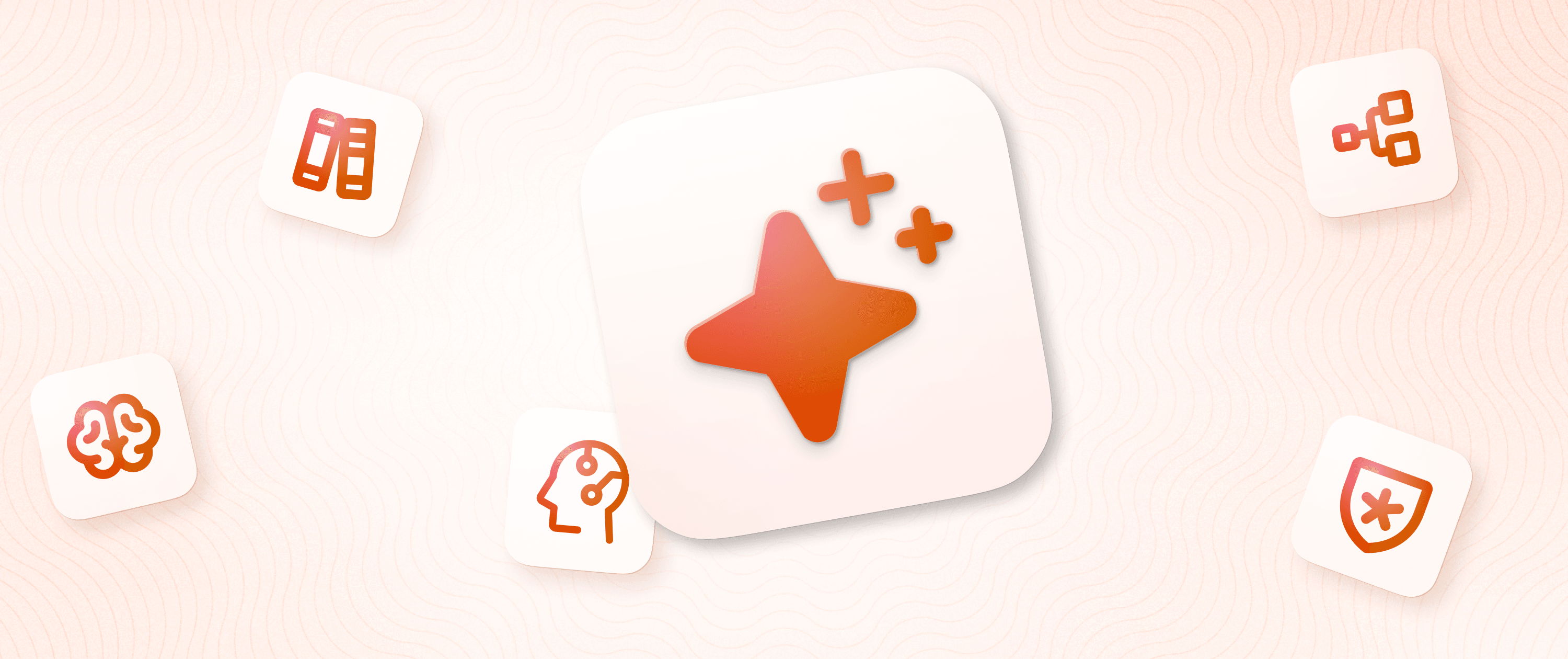Accelerating Customer Support Automation with a Custom Single Customer View


Digitization and automation are priorities for most customer service organizations. But customer care leaders continually run into roadblocks, according to a recent study by McKinsey. 77% of organizations have built digital support platforms, but only 10% have fully scaled them, and only 12% of the platforms are highly integrated.
What’s hindering progress here? It’s not so much a technology problem as a process complexity problem. This article unpacks some of the reasons that organizations struggle with support automation and explores how custom software solutions can unblock agent productivity and customer satisfaction.
Disjointed customer data hinders support automation
Let’s first take a step back and briefly discuss aspects of support automation. Often the ideas of digitization or automation within the realm of customer support are targeted at self-service solutions: interactive training, documentation, or chatbots that help customers solve their own issues. There is, however, another important aspect: automation for support agents that allows them to more productively respond to customer issues.
There are, obviously, many available tools that are designed to help customer support agents. Most organizations have some combination of knowledge base, contact center, issue management, and/or ticketing software that support teams use. The automation challenge comes from the persistent gaps between these and other systems that agents have to access/reference in order to complete their work.
Let’s look at an example:
A support agent receives an inquiry from a customer via a software ticketing system. The customer reports that something isn’t set up correctly in their account.
The ticketing system doesn’t have enough information about the customer to diagnose the issue, so the support agent moves to the company’s CRM system where the customer details, transaction history, and account information are stored.
The customer is correct: there’s been an error in their account setup, and some settings need to be changed. The account settings, however, are managed in an internal database that support agents don’t have access to.
The company uses project management software for internal issue tracking. The support agent creates an issue, and assigns it to the data team.
The support agent tracks the issue resolution and, when the account updates are completed, goes back to the ticketing system to respond and resolve the customer’s ticket.

This is a fairly simple and standard request, but a typical process requires the support agent to manually work across multiple systems and data sources. These persistent “digital gaps” limit the productivity of support agents and prevent customer issues from being resolved as quickly as they could be.
Resolution speed is a critical component of customer experience. A recent PwC study found that speed and efficiency were the most important elements of customer service for 80% of consumers. Companies that can effectively bridge the digital gaps in their support processes will have a built-in competitive advantage when it comes to customer experience.
Support automation starts with a good single customer view
What is a single customer view? Also known as a customer 360, a single customer view is a digital record, usually presented visually, that combines all of the relevant data about a customer across multiple sources.
For customer support teams, a single customer view provides all of the contextual information they need to fully evaluate and understand concerns or issues that customers raise. Information that is typically integrated into a single customer view for support agents includes:
Personal details and contact information for the customer
A history of their support requests and interactions with support agents. This helps agents understand and identify any long-running issues that may be relevant to the current issue they’re evaluating.
Purchase/transaction history. This information will obviously vary depending on business and industry. For services industries like finance, telecom, etc., this would likely be an account status history. For retail/e-commerce this would be a purchase history. Support requests are often related to a recent transaction, so this information is particularly relevant.
Other interactions the customer has had with a knowledge base or documentation or social media accounts. Have they researched solutions to their issue? Have they raised issues or complaints in other channels? This can be important, relevant information as well.
The challenge, of course, with putting together a single customer view is that all of this underlying information isn’t integrated. It’s stored across multiple SaaS applications, data warehouses, and legacy systems. Building a view on top of all this data often requires a prohibitively heavy data engineering/consolidation project before any information can be surfaced.
Visibility alone isn’t sufficient
The other key challenge when it comes to building a single customer view for support teams is that support teams don’t just need to view data. They need the capability to take action on that data. Typical customer engagements can require a support agent to:
Update customer details or contact information
Trigger escalations or issues for other teams (security, engineering, etc.) to help with a customer issue
Make changes to orders or account settings
A single customer view that can’t support these basic update functions is of limited utility to support agents. This means that IT teams that are implementing can’t simply think of this as a BI (business intelligence) or dashboard project. Effective support tools need CRUD (create, read, update, delete) functionality for any information that is presented in a customer view.
Low-code tools provide a powerful solution to support automation challenges
We’ve highlighted data integration challenges and the need for interactivity (data updates) as key inhibitors of full support automation, but there’s another important consideration: the highly bespoke nature of support processes. Customer experience is a critical component of business success, and many organizations attempt to cultivate a superior customer experience as a competitive differentiation.
As a result, organizations develop specific, specialized processes for customer interactions: processes that they’re not typically willing to compromise in the name of digitization or automation. This factor is another important reason that packaged software can support some aspects of support processes (ticketing, CRM, etc.), but doesn’t do a good job of automating end-to-end processes. It simply doesn’t provide the customization or the integration that organizations need.
This naturally leads to the idea of building custom software. This is often a better approach for support processes — organizations can build digital workflows that align with their desired processes, and applications can be built on top of multiple existing data sources without requiring significant data engineering. However, this idea pretty quickly runs into the reality of resource scarcity. Most IT organizations simply don’t have the development resources to take on the full development and maintenance of solutions like this.
Low-code application platforms can offer the best of both worlds. They’re much less resource-intensive than developing solutions from scratch and can provide an equally good time-to-value as many SaaS applications. But, unlike SaaS applications, solutions built in a low-code platform are highly flexible and can be fully customized to support an organization’s unique support processes.
Things to consider when building a single customer view or other support tools with a low-code platform
While low-code platforms can be a good solution for support automation, there are important considerations to keep in mind when evaluating the fit of a potential platform:
Datasource access. The principal challenge that prevents effective support automation is the fact that relevant customer data lives in multiple locations. Organizations should make sure that any low code platform can easily connect, pull, and update information from SaaS applications, APIs, and databases.
App embedding. Sometimes the best solution isn’t to build a separate stand-alone application. In most organizations support agents are using existing, often useful, tools as part of their day-to-day activities. Extending these tools/interfaces with additional functionality and information can be an effective development approach. Organizations should look for low-code platforms that can support these types of deployments.
Access controls. Can tools built with a low-code platform inherit an organization’s users, permissions, and access controls? For example, front-line and second-line support agents might need to see different information and have access to update different records. Most low-code tools provide authentication, but not all can support this level of granular access control.
Comprehensive UI building. Typically the biggest time savings that come from low-code platforms is in UI development. The ability to visually compose drag-and-drop elements into a functional user interface is massively faster than coding from scratch — even using development frameworks. However, there are several specific requirements for a support-focused single customer view that organizations need to be mindful of. Low-code platforms should be able to offer detailed data visualization capabilities alongside forms and functions to execute updates.
Ease and cost of implementation. If a low code platform is too complicated or too expensive to implement, it’s not going to provide the promised time or resource savings. Organizations should clearly evaluate the effort and cost and the expected time-to-value for any prospective solution.
Customer support automation with a comprehensive single customer view
Support automation — both self-serve capabilities for customers and process automation for support agents — is important for customer experience. Above all, customers value speed and efficiency in customer service. When investing in digital tools for customer support, organizations shouldn’t overlook the needs of support agents and the opportunity to increase their productivity. Ticket deflection (which is typically the success measure for these types of initiatives) is a good goal, but rapidly resolving tickets that are created is just as important.
When support agents are armed with a comprehensive single customer view that allows them to see all of the contextual information around a support request at a glance and provides capabilities to update customer information, orders, or account details, they can resolve customer issues much, much faster. These capabilities aren’t easily fulfilled with packaged software, but with the right low-code solution, organizations can develop fully custom support solutions without additional time and cost.
Let’s revisit the example we discussed at the beginning of this article and see what that would look like with a comprehensive single customer view in place:
A support agent receives an inquiry from a customer via a software ticketing system. The customer reports that something isn’t set up correctly in their account.
A custom extension embedded within the ticketing system automatically pulls additional customer information from the CRM and internal systems, giving the agent all the information they need to evaluate the request without moving between systems.
An integrated form allows the agent to directly make the requested updates to the customer’s account. The custom view updates the internal database directly while providing guardrails that prevent any bad or mis-formatted information from getting into the system.
In this updated scenario the ticket has been resolved in a matter of minutes, and the support agent doesn’t have to bounce between multiple tools to do so. That’s the power of an integrated single customer view!

Get started with your custom single customer view
Customer support teams at HIFI (part of Block), Dropbox, and Fyle have built highly-functional single customer view applications using Appsmith’s low-code platform. The flexibility of data access, developer friendliness, and ease of implementation make Appsmith a strong accelerant for teams that are looking to build custom support solutions.
Here are a few resources you can use to get started:
Appsmith template: Start building with a ready-made application template
Get started for free: Appsmith offers a fully-functional cloud or self-hosted free tier
Appsmith tutorial: Build TicketSmith: a Zendesk Clone


